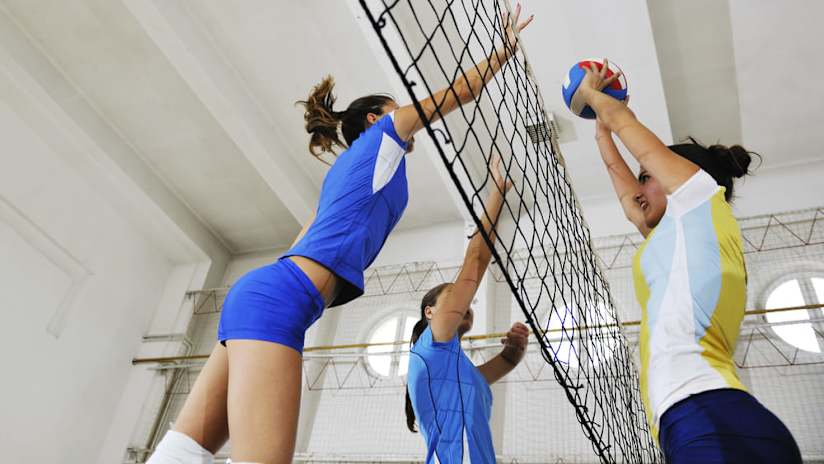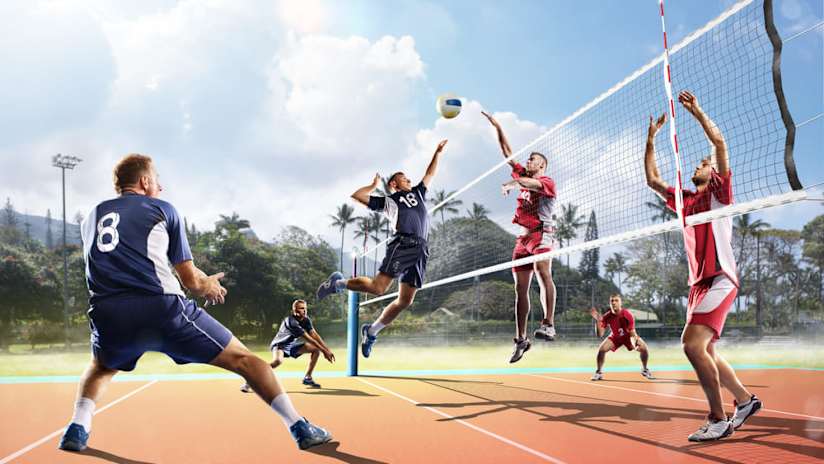The setter is the one who sets up the shot for a hitter to spike the ball into the opponent’s court. You often see them taking the second shot and positioning their shot directly in front of the hitter, providing the perfect angle for them to spike the ball. The setter is the decision-maker on the team and leads them when they’re playing offense.
Outside Hitter
The outside hitter hits and blocks on the left side of the front line. The outside hitter usually gets the most sets because their dominant right arm is on the side of their teammates, and they're generally among the tallest and strongest players on the team. Their responsibilities include hitting from the front or back row, playing middle-back defense and blocking.
Opposite Hitter
Opposite hitters play from the right side of the court, and their title comes from being positioned opposite the strong outside hitter. They have the same primary role as the outside hitter, hitting out of the front and back row, passing, and playing defense. Their role also includes blocking the other team’s outside hitter.
Middle Blocker
Middle blockers are typically some of the quickest and most agile members of a volleyball team. They’re also the best blockers and participate in fast sets from the center of the court behind the setter.
Libero
Liberos stand out because they wear a different colored jersey and play in the row for five out of six rotations, usually subbing for one of the two middle blockers. Liberos are defensive specialists who are fast and agile and able to return balls that others might miss. They typically play from the back line and can only set a front-row teammate from behind the 10-foot line.
Defensive Specialist
Defensive specialists play the same sort of role as the libero, returning and setting fast-moving return balls. They wear the same color jersey as the rest of the team and are required to observe normal substitution rules. They play for three out of six rotations.
Serving Specialist
These players rotate in just because they have a very hard-to-return or consistent serve. They typically come in for a player who is less strong behind the service line but is valuable to have on the court.
Positions and Roles in Beach Volleyball
As there are only two players per side in beach volleyball, each of the players must be skilled at blocking and defending, although usually the taller player in a team is placed at the net to block the other team's shots, and the more agile player plays in the backcourt to defend the other team's shots.
Communication is crucial in beach volleyball. Both players diving for a ball can cause injury or leave the rest of the court wide open. Players who have a lot of experience playing as a team can know each other's moves so well that they can instinctively block, defend and provide sets for each other.
Typical Sequence of Events to Score a Volleyball Point
One of the most fascinating aspects of watching a talented volleyball team in action is observing the way they choreograph a point attempt.
The defender will typically stop a serve with a gentle return to the setter or middle blocker. They, in turn, will create the perfect angle for the outside or opposite hitter to reach and spike the ball into the opponent's court. Using all three of the permitted shots is the perfect way to slow the game down and allow the players to quickly get in the correct position to score a point.
Watch VBTV to Learn More About the Game
With the Paris Olympic Games starting in July, now is the perfect time to further acquaint yourself with the exciting game of volleyball. VBTV will broadcast all the most important qualifying volleyball matches around the world in the lead-up to the summer games. We'll also be showing all the beach and indoor volleyball matches at the Paris Olympic Games. What better way to watch and root for the best volleyball teams and players in the world? Subscribe to VBTV today.







